Countywide Action Plan (CAP)
More than half of Lancaster County’s 1,400 miles of streams, and much of its groundwater, are unhealthy.
Because of this, the Environmental Protection Agency designated the county as a priority area to reduce nitrogen and phosphorus loads by 2025. The Lancaster Countywide Action Plan (CAP) outlines Lancaster’s path for reducing 11.7 million lbs. of nitrogen and 524,000 lbs. of phosphorus by the 2025 deadline.
Developed through a grassroots approach, the CAP embraces collaboration and scientifically-based practices as the main strategies for achieving ambitious, yet realistic, reduction goals. The plan includes a diverse collection of conservation practices on different land uses in the county.
To learn more about the background behind CAP, click here.
Funding for these projects is from the Pennsylvania Department of Environmental Protection’s Countywide Action Plan Implementation grant to Lancaster.
Lancaster County streams have the biggest restoration opportunity of any monitored areas of the Chesapeake Bay watershed. With a mixture of rural, suburban and urban landscapes, the sources for water pollution are broad – but, so are the opportunities for conservation and restoration.
Join our vision of Clean & Clear by 2040!
Picturing Clean & Clear by 2040!
This past year, Lancaster continued to live out a culture of stewardship, anchored in commitment to protect heritage and natural resources for future generations. Here is a review and pictures of some of the work done through CAP in 2022.
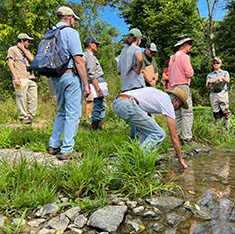
Multi-county habitat assessment training
Jim Harnish, water quality monitoring volunteer with the Octoraro Watershed Association, reaches into Dellinger Run during a visual habitat assessment training planned in partnership with Chesapeake Conservancy. The training brought representatives from across Lancaster County and several neighboring counties (Blair, Centre, Snyder, and Union). Visual habitat assessments are a critical piece of the rapid stream delisting strategy because it’s the first step in getting a stream off the impaired list. This training, coupled with the coordinated monitoring work from the Water Quality Monitoring Action Team, will advance the delisting strategy and assist in tracking water quality progress.

More efficient processes
Partners break the ice with a fun team-building exercise at the June 2022 full Partners meeting, where organizations came together to brainstorm ideas for more efficient processes. We heard from everyone about capacity needs and specific areas where we could use our voice to improve bigger processes. This year we’ve welcomed new voices of all kinds, but specifically two of those are team members at the Conservation District to help with CAP goals like data management, grant administration, and capacity building. This capacity supports partners across the county to accomplish more because of the collaborative way Lancaster operates.

Creation care inching us closer
A butterfly sits on phlox, a native shrub, in a maturing pollinator garden at Ridgeview Mennonite Church in eastern Lancaster County. This year, we’ve seen tremendous growth in conservation connections from faith-based work, which is an essential part of our diverse community. From Grace Lutheran Church’s focus on green infrastructure to Ridgeview Mennonite’s new native garden, leaders like Interfaith Partners for the Chesapeake make caring for the natural world an easier way to achieve local conservation goals as well as bring new voices to the table for bigger success.
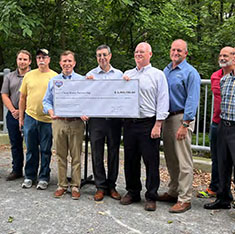
Collective grant asks for sustainable funding
The Lancaster County Board of Commissioners presents a check to the Lancaster Clean Water Partners, Conservation District of Lancaster County, and several partner organizations at the Conewago Recreational Trail trailhead. In July, the County Commissioners voted unanimously to approve $3.4 million from the county’s American Rescue Plan Act (ARPA) funding for 11 water quality projects. This represents the largest single investment in preserving clean water in Lancaster County government history. The projects leverage several funding sources, including implementation funding from the state. The collective application is just one method the Partners is using to pursue sustainable funding for conservation implementation.
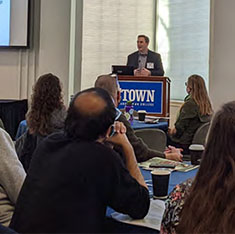
Sharing research and collaborative approaches
Matthew Royer presents at the Lancaster-Lebanon Watershed Forum and Science Symposium in November 2021 at Elizabethtown College’s campus. Organizations worked together to design the agenda that reflected student work as well as industry-specific progress. The two-day event featured research presentations and a forum for collaborative watershed work, attracting 225 attendees. Penn State hosted the third PA in the Balance Conference in December 2022 to bring motivated leaders in our agricultural and environmental community together to continue building on recent momentum, developing collaborative strategies to achieve PA’s common goals between agriculture and water quality.

Increasing capacity through Watershed Leadership Academy
Seven scholars in the Lancaster Watershed Leadership Academy graduated from the inaugural class in December 2021. The next cohort of scholars will begin classes in January 2023 to learn the basics of watershed management, the benefits of conservation practices on varying land uses, different leadership styles, and creative ways to lead clean water projects. The Academy is already proving to add valuable capacity to Lancaster County’s clean water work. One scholar changed from a career in investment banking to a career in environmental water management solutions. Another works in advocacy but started consulting with the Pennsylvania Fish and Boat Commission to translate boating safety messages into Spanish. And another has helped launch a river story collective in downtown Lancaster.
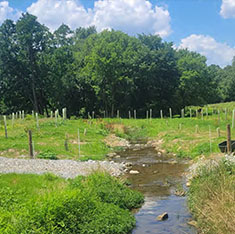
Holistic conservation planning
Conservation practices were implemented along a small tributary to the Mill Creek in East Lampeter Township to alleviate flooding and other stormwater issues due to high amounts of impervious surface
upstream. When heavy rains come, the landowner could not let his animals out into the pasture because of high-levels of flooding. Funded by 319, the property now displays a stream restoration project involving 1,300 linear ft. of bank stabilization and instream habitat improvements in addition to a 35 foot riparian forest buffer.
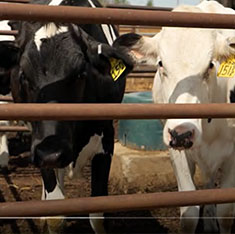
Conservation for the next generation
Two dairy cows stand in an upgraded “loafing area” on Jonas Fisher’s farm in the Pequea Creek Watershed. The conservation practices installed on his land, including the loafing area, manure storage,
paved animal walkway, and fencing, will significantly improve animal health and local and Bay-wide water quality. Jonas Fisher, one of the three farmers having conservation practices installed through a Clean Water Fund grant managed by Lancaster Farmland Trust, is excited about the tremendous improvements he’s already seeing on his farm. He’s eager to pass along the farm to one of his sons and for the conservation practices to be an example to the next generation of dairy farmers.
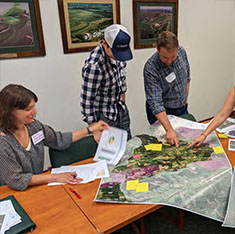
Moving the needle with the stream delisting strategy
Partner organizations investigate maps of priority catchments in Lancaster County to identify areas for potential delisting where we will focus outreach and implementation efforts to agricultural landowners. After a little over a year of employing the stream delisting strategy, partners have completed outreach to approximately 39% of landowners of high-priority farms, with outreach anticipated to be complete by the end of 2022. Across all catchments, implementation is on track for 76% of the agricultural restoration goals and 84% of buffer restoration goals. Twelve of the 21 catchments are on track to meet restoration goals by 2024.

Place-based connections for continued learning
Outdoor experiences like this, our MS4orum event for municipal staff and engineers, provided place-based connections and engaged partners in value-add, relevant learning experiences that also provided networking opportunities. This is one event of many that happened across Lancaster for local audiences like MS4 professionals as well as Bay-wide audiences such as the Chesapeake Bay Commission and the Scientific and Technical Advisory Committee. Field investigations help all of us collaborate more and operate as systems thinkers.
CAP Coordinator Team
The CAP Coordinator Team is comprised of Land Studies Inc., Lancaster Farmland Trust, David Miller/Associates and Lancaster County Conservation District. Collectively, with the Lancaster Clean Water Partners, they coordinate and support activities for Lancaster County’s Countywide Action Plan. They reasearch and share new and creative clean water funding opportunities for cross-sector partners and are invloved in projects from planning to implementation and report the results to the DEP and the EPA.
MONTHLY NEWSLETTER
Subscribe to our monthly newsletter and stay up to date on what we've accomplished, county news, job openings, and more!
BECOME A PARTNER ORGANIZATION
If you share our vision of clean and clear water in Lancaster County by 2040, we want to hear from you!




